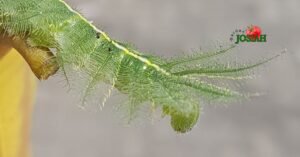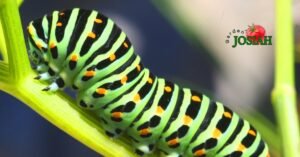Butterflies and moths, along with some other insects and frogs, go through a remarkable change called metamorphosis1. This is a big change in their form or structure. It also involves changes in their body, chemistry, and behavior. The life cycle of green caterpillars has four main stages: egg, larva (caterpillar), pupa (chrysalis or cocoon), and adult1.
During the caterpillar stage, the insect grows fast and sheds its skin many times. This process is called molting or instars1. It helps the caterpillar get bigger and ready for the next stage of its transformation.
Key Takeaways
- Butterflies, moths, beetles, flies, and bees undergo complete metamorphosis with four stages: egg, larva, pupa, and adult1.
- Caterpillars can grow up to 100 times their initial size during the larval stage1.
- The pupal stage can range from a few weeks to two years depending on the species1.
- Butterfly eggs can be very small1.
- Female butterflies lay multiple eggs to ensure survival of at least some offspring1.

The Miraculous Metamorphosis
Understanding the Four Stages
The life cycle of butterflies and moths is truly amazing. It’s called complete metamorphosis. This journey has four main stages: egg, larva (caterpillar), pupa (chrysalis or cocoon), and adult2.
In the caterpillar stage, the insect grows fast. It sheds its skin many times, called molting or instars2. This helps the caterpillar get bigger and ready for the next stage3.
The pupa, or chrysalis, is a key stage. Inside, the insect changes a lot. Special cells grow to form the adult butterfly’s legs, wings, eyes, and more3. When it’s done, the adult butterfly comes out. It has long legs, antennae, compound eyes, and can fly with its colorful wings2.
This amazing change shows nature’s incredible skill and the adaptability of these creatures2. Each stage of a butterfly’s life is full of unique changes and adaptations. It shows how complex and strong these winged wonders are2.
The Egg: A Tiny Beginning
The life cycle of green caterpillars starts with the butterfly egg. These eggs are tiny and full of detail, marking the beginning of a magical change. Female butterflies lay their eggs on plants that will feed the caterpillar hatching from them, giving the young ones a good start4.
These eggs are often as small as a pinhead5. When they are laid can vary, with some butterflies doing it in spring, summer, or fall4. Female butterflies usually lay many eggs, knowing only a few will make it through the egg laying process5.
| Egg Characteristics | Monarch Butterfly |
|---|---|
| Height | 1.2 mm5 |
| Width | 0.9 mm5 |
| Incubation Period | 3-5 days5 |
The green caterpillar’s journey starts with a tiny, amazing butterfly egg. When it hatches, a new chapter begins, leading to a fascinating transformation.
“The egg is the start of a miracle, the beginning of a life that will soon take wing and soar.”
4– The Life Cycle of Butterflies5– Monarch Life Cycle

From Caterpillar to Butterfly: The Life Cycle of Green Caterpillars Explained
The life cycle of green caterpillars is truly amazing. The caterpillar, or larva, is a key part of their transformation6. These hungry eaters can grow up to 100 times bigger, shedding their skin several times6.
Butterflies and moths go through four stages: egg, larva (caterpillar), pupa (chrysalis or cocoon), and adult7. Most caterpillars molt five times, changing a lot in each stage6. For example, a Spodoptera exigua caterpillar grows from 1.2 milligrams to 254.1 milligrams in the fifth molt6.
The caterpillar’s main job is to eat and grow. This prepares it for the next stage, becoming a pupa or chrysalis7. This amazing change allows the caterpillar to turn into a beautiful butterfly7.
The life cycle of green caterpillars is a stunning example of nature’s creativity. It shows the incredible changes these creatures go through from egg to butterfly678.
The Chrysalis: Nature’s Transformation Cocoon
Unveiling the Metamorphic Process
When a caterpillar finishes growing, it enters the pupa or chrysalis stage. This is a magical change that shows the beauty of nature’s transformation9. The caterpillar breaks down its body and releases enzymes to dissolve its tissues. Yet, special groups of cells called imaginal discs survive and grow into the adult butterfly’s features, like wings and eyes9.
Some muscles and parts of the nervous system from the caterpillar stay in the adult butterfly9. For instance, a fruit fly’s wing imaginal disc starts with about 50 cells and grows to over 50,000 by the end of its transformation9.
The chrysalis stage is key in a butterfly’s life cycle10. Monarch butterflies should not stay in a black chrysalis for more than 3 days. This could mean they have a bacterial infection or are being eaten by predators10. If a chrysalis stays dark for at least five days with no orange wings inside, it means the monarch butterfly is dead10.
The change from caterpillar to monarch butterfly usually takes up to two weeks in summer. But, late-forming monarchs might stay in their chrysalis all winter, coming out healthy after 10-12 weeks10. Sometimes, monarch butterflies take up to 45 minutes to come out of their chrysalis. This could mean they have a problem or disease10. Chrysalises don’t need food or water. But, misting the area with water helps keep the humidity right for their growth10.
“The chrysalis stage is a remarkable transformation that showcases the wonders of nature’s metamorphosis.”
The Adult Butterfly: A Winged Wonder
The adult butterfly is the final stage of the green caterpillar’s life cycle. It looks very different, with long legs, antennae, and colorful wings11. Its main job is to mate and lay eggs, keeping the species alive11.
Some butterflies eat nectar from flowers, while others don’t eat at all11. They live for just one to two weeks. Yet, they are crucial for finding food and laying eggs for the next generation11.
The butterfly life cycle has four stages: egg, larva (caterpillar), pupa (chrysalis), and adult11. During metamorphosis, the caterpillar’s body breaks down and reorganizes into a butterfly11. Butterflies and moths go through these stages: egg, caterpillar, pupa, and adult12. Caterpillars shed their skin five times to grow12.
Butterflies are important indicators of environmental health. A drop in their numbers can mean bigger ecological problems like habitat loss or pollution11. They also help with pollination by feeding on flower nectar, which supports plant reproduction11.
| Butterfly Life Cycle Stage | Duration |
|---|---|
| Egg | 3-10 days |
| Caterpillar | 2-6 weeks |
| Pupa | 1 week to 1 year |
| Adult Butterfly | 1-2 weeks (some species can live for several months) |
The transformation from pupa to adult can take from a week to a year, depending on the species12.
“Butterflies are a symbol of transformation, representing the journey from caterpillar to winged beauty.”
Conclusion
The life cycle of the green caterpillar is truly amazing. It starts as a tiny egg and turns into a beautiful butterfly. This change is a wonder of nature’s magic13.
Butterflies are incredible with their detailed wings and color vision. Their ability to adapt shows the power of evolution13.
The life cycle of the green caterpillar shows how everything in nature is connected14. The caterpillar needs certain plants to survive and has ways to avoid predators. Each part of its life is designed to help it live14.
This connection between the caterpillar and its world teaches us about the balance in nature. It’s a lesson in how fragile and strong our world is at the same time14.
Watching a green caterpillar turn into a butterfly is inspiring. It shows how nature can be both strong and fast15. The life of these creatures is a reminder of the beauty around us, if we only look15.
As we try to keep our world safe, the story of the green caterpillar is very important. It teaches us why we must protect all life on Earth15.
FAQ
What is the life cycle of green caterpillars?
Green caterpillars go through four stages: egg, larva (caterpillar), pupa (chrysalis or cocoon), and adult.
How do caterpillars grow and prepare for the next stage?
Caterpillars grow fast and shed their skin many times. This is called molting or instars. It helps them get bigger and ready for the next stage.
What happens during the pupa or chrysalis stage?
In the pupa or chrysalis stage, big changes happen inside. Special cells grow into legs, wings, eyes, and other adult butterfly parts.
How does the adult butterfly emerge and what are its characteristics?
When the adult butterfly comes out, it has long legs, antennae, compound eyes, and can fly. Its wings are large and colorful.
What is the purpose of the adult butterfly?
Adult butterflies mainly mate and lay eggs to keep their species going. Some eat nectar from flowers, but others don’t eat at all.
Source Links
- Butterfly Life Cycle
- From Caterpillar To Butterfly (Butterfly Life Cycle & Metamorphosis Explained) – Revive A Bee
- How does a caterpillar turn into a butterfly?
- The Life Cycle of a Butterfly | AMNH
- Life Cycle
- New Page 2
- Butterfly Metamorphosis | American Museum Of Natural History
- Metamorphosis, explained
- How Does a Caterpillar Turn into a Butterfly?
- Chrysalides: The Good and the Bad | The Butterfly Musketeers
- Butterfly Life Cycle for Students | Gardens with Wings
- Life Cycle of Butterflies and Moths
- Life Cycle of A Butterfly
- Caterpillar | Definition, Insect, Types, & Facts | Britannica
- Design Features for the Monarch Butterfly Life Cycle







